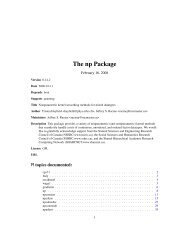The gstat Package - NexTag Supports Open Source Initiatives
The gstat Package - NexTag Supports Open Source Initiatives
The gstat Package - NexTag Supports Open Source Initiatives
Create successful ePaper yourself
Turn your PDF publications into a flip-book with our unique Google optimized e-Paper software.
predict.<strong>gstat</strong> 37Detailsna.actionsps.argsfunction determining what should be done with missing values in ’newdata’.<strong>The</strong> default is to predict ’NA’. Missing values in coordinates and predictors areboth dealt with.when newdata is of class SpatialPolygons or SpatialPolygonsDataFramethis argument list gets passed to spsample in package sp to control the discretizingof polygons... ignored (but necessary for the S3 generic/method consistency)When a non-stationary (i.e., non-constant) mean is used, both for simulation and prediction purposesthe variogram model defined should be that of the residual process, not that of the raw observations.For irregular block kriging, coordinates should discretize the area relative to (0), (0,0) or (0,0,0);the coordinates in newdata should give the centroids around which the block should be located.So, suppose the block is discretized by points (3,3) (3,5) (5,5) and (5,3), we should pass point(4,4) in newdata and pass points (-1,-1) (-1,1) (1,1) (1,-1) to the block argument. Although passingthe uncentered block and (0,0) as newdata may work for global neighbourhoods, neighbourhoodselection is always done relative to the centroid values in newdata.If newdata is of class SpatialPolygons or SpatialPolygonsDataFrame (see packagesp), then the block average for each of the polygons or polygon sets is calculated, using spsampleto discretize the polygon(s). sps.args controls the parameters used for spsample. <strong>The</strong> "location"with respect to which neighbourhood selection is done is for each polygon the SpatialPolygonspolygon label point; if you use local neighbourhoods you should check out where these points are—this may be well outside the ring itself.<strong>The</strong> algorithm used by <strong>gstat</strong> for simulation random fields is the sequential simulation algorithm.This algorithm scales well to large or very large fields (e.g., more than 10 6 nodes). Its power liesin using only data and simulated values in a local neighbourhood to approximate the conditionaldistribution at that location, see nmax in krige and <strong>gstat</strong>. <strong>The</strong> larger nmax, the better the approximation,the smaller nmax, the faster the simulation process. For selecting the nearest nmax data orpreviously simulated points, <strong>gstat</strong> uses a bucket PR quadtree neighbourhood search algorithm; seethe reference below.For sequential Gaussian or indicator simulations, a random path through the simulation locationsis taken, which is usually done for sequential simulations. <strong>The</strong> reason for this is that the localapproximation of the conditional distribution, using only the nmax neareast observed (or simulated)values may cause spurious correlations when a regular path would be followed. Following a singlepath through the locations, <strong>gstat</strong> reuses the expensive results (neighbourhood selection and solutionto the kriging equations) for each of the subsequent simulations when multiple realisations arerequested. You may expect a considerable speed gain in simulating 1000 fields in a single call topredict.<strong>gstat</strong>, compared to 1000 calls, each for simulating a single field.<strong>The</strong> random number generator used for generating simulations is the native random number generatorof the environment (R, S); fixing randomness by setting the random number seed withset.seed() works.When mean coefficient are not supplied, they are generated as well from their conditional distribution(assuming multivariate normal, using the generalized least squares BLUE estimate and itsestimation covariance); for a reference to the algorithm used see Abrahamsen and Benth, Math.Geol. 33(6), page 742 and leave out all constraints.
















